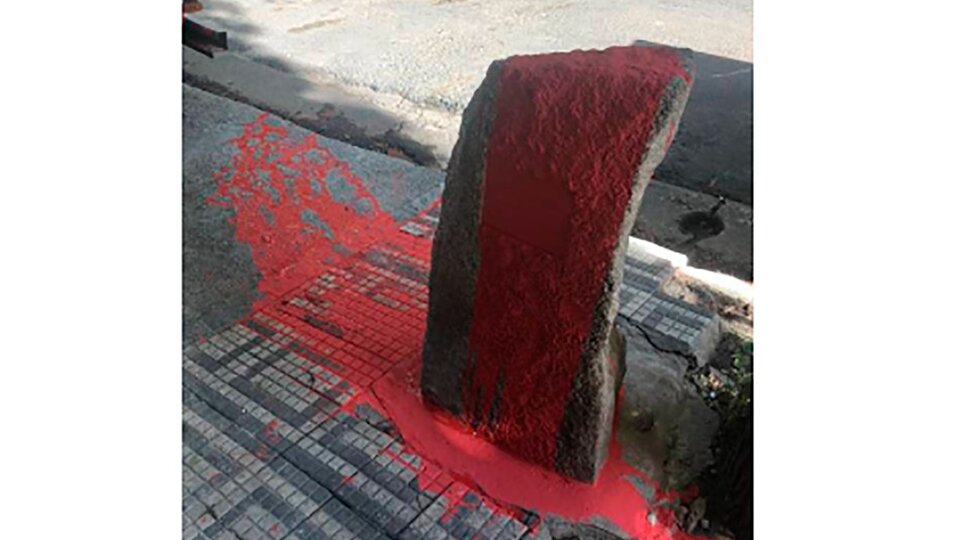
A Granite stone, exceeding one meter in height, coexists with a neighboring tree. Hard to find if it happens. It is not marked. No one who passes checkered tiles on a sidewalk will notice its meaning unless they know its history. Like a monolith that has been destroyed over and over again. They threw red dye on him They also stole the plate attached to him. It is located at 815 Alameda Casa Branca street, one of the most convenient in San Pablo. Today Remains of Carlos Mariguela Monument. At that place, on November 4, 1969, dozens of members of the DOPS (Department of Socio-Political Order) were ambushed and killed by four bullets. Communist Guerrilla. A symbol of resistance against the Brazilian dictatorship A Bahian militant, a political prisoner for almost a decade, an outlaw partner, a writer and a brilliant engineering student.
Just stone
Jean Paul Sartre declared his admiration and supported his cause from France. George Amato, his companion from the bench at the PC, shared with him texts that others had read. Caetano Veloso He dedicated the song Un Communist to him. Architect Oscar Niemeyer designed the headstone for his tomb in Bahia. Wagner Maura directed a blockbuster film bearing his name. That’s Mariguela, a stone-faced, revolutionary man whose memory haunts the era of retired President Bolsonaro.
“A Mulatto from Bahiavery tall and mulatto, the son of an Italian and a black Hausa woman” sings Veloso in his well-known song of 2012. A century ago, on December 5, 1911, Mariquela was born in Salvador de Bahia. Dear, Author Leaders of the arena, revived him in another of his novels. He called the character by his first name, Carlos. Guerrilla was a tall man who wore glasses, had an easy smile, loved samba music and never shied away from household chores. His father, a socialist mechanic, showed him the initial path to the left.
He joined the PCB at a very young age and was jailed for the first time in 1932. The arrests would be a constant marker in his life. He was imprisoned on two islands: Fernando de Noronha and Ilha Grande. The first was converted into a military base when Brazil entered World War II.
The Garden neighborhood A native of São Paulo who breathes in Ibirapuera Park – steep streets, tall buildings and the city’s biggest lungs – knows little about that past history. Since the theft of the plaque placed in 1999, during the government of Celso Pitta – the second black mayor in the history of São Paulo, on the 30th anniversary of the disappearance of the body of the guerrilla: “Carlos Mariguela fell here on 4/11. /69, assassinated by the military dictatorship”, it said. Less than a year after its inauguration, it was already destroyed. One nostalgic for the military dictatorship wrote: “The terrorist Carlos Mariguela was hanged here. Justice prevailed here.”
Today only a plaque marks the stone. A piece of granite that neighbors’ dogs usually urinate on and left-wing militants from Brazil and other countries usually make a pilgrimage to, namely the intellectuals who signed a petition to place the monolith 23 years ago.
There’s a bar on the corner half a block away. We asked the waiter for directions on the memorial and he didn’t know what to say. No counter staff either. It is necessary to appeal to a parishioner with an ambiguous reference, as if to mention a forbidden character to ask about Marigella. Someone who relentlessly harassed the Brazilian dictatorship in collaboration with the CIA. But he is remembered with respect by the Latin American revolutionary movement.
Around the memorial, tourists took photos and soldiers paid their respects. In one in 2013, San Pablo’s Truth Commission and Guerrilla’s Widow Clara Scharf, now 97 years old. But those who focus too much on that piece of granite are its opponents. They don’t want her around. And he’s less likely to remember who they define as a “terrorist.” One of the graffiti he was attacked with a few years ago bore the symbol of McCarthyism: “CCC”, meaning “Commando de Casa Aos Communistas”. In Spanish, Comando de Casa a los Communistes.
The granite mass, passive and discreet, is still there. It can never be removed. On the night Mariguela was killed, the Santos-Corinthians football classic was being played three kilometers away in the cobblestoned Casa Branca – now on the pavement. It also coincided with a last-ditch hunt for the gorillas, which was doggedly pursued by the regime’s secret police, DOPS, which was postponed for days due to incessant rains in the state capital. Author of Urban Guerilla Fighter’s Minimanual, a blog of sorts for revolutionaries who have chosen the path of armed struggle.
Journalist Mario Magalhas, author of the book Marigella: The gorilla that set the world on fire, stating that his execution had already been completed when the match began. The most wanted person for the regime will be on the cover of all the newspapers the next day. Sergio Paranhos Fleury, head of the operation, took his time to cover the scene. He turned a firing squad on a Volkswagen Beetle of a Bahian fighter with such firepower into a confrontation between two squads. By then, what would become the Jardim neighborhood decades later was already in sight. A billboard in front of the set read: “High-end apartments, 2,500 square feet”. Today these types of houses have multiplied by the thousands. Towers of amenities dominate the urban landscape of a city that ignores that bloody past and doesn’t want to live with a piece of granite that reminds it.
[email protected]

“Introvert. Thinker. Problem solver. Evil beer specialist. Prone to fits of apathy. Social media expert. Award-winning food fanatic.”

:quality(85)/cloudfront-us-east-1.images.arcpublishing.com/infobae/LKGZZPZZ6THIZNWF5WHDNKDV64.jpg)


More Stories
Russia destroyed postal infrastructure in Odessa in another ballistic missile attack
Agenda and his introduction to ARG 01
Celia Flores had an embarrassing moment in the middle of Nicolás Maduro's chain for Labor Day